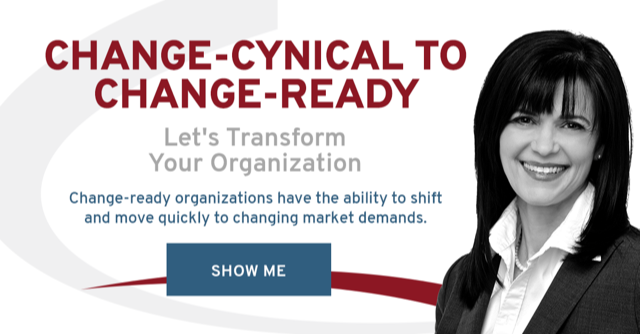Do you have a smartphone? I do, and every leader I work with does. It has become an essential leadership/management tool. Yet it isn’t the number one communication tool in your leadership toolkit. Its use can even hinder your change efforts.
We live in a world of instant communication. There is Facebook, Instagram, Snap chat, Twitter, LinkedIn, and the old fashioned way – email.
All these tools give us the illusion of communication.
Mark Twain said, ”Let’s make a special effort to stop communicating with each other, so we can have a conversation.”
Conversation is the Number One Communication Tool in Your Leadership Toolkit.
Conversation is the most powerful communication tool in your organization. It’s the best tool for leading and growing your organization, and for change. It is also the tool leaders fear, undervalue, and don’t use often enough to enable change. Failing to use conversation increases your risk of failure—your most powerful communication tool becomes the tool that sabotages your change efforts.
The Power of Conversation
One CEO discovered the power of conversation when a merger reached a critical point. Long time managers on both sides of the merger were leaving the organization. Some departures were the manager’s decision and some were an organizational decision.
Regardless of why the managers left the CEO knew to get the benefits of the merger she had to communicate. She needed to talk about the departures.
The typical approach would have been a well-crafted email. But that’s not what she did. Instead, she set up a series of one-on-one in-person conversations. This was not easy. The organization was geographically spread out. She had to make the time for each conversation. She also had to travel as much as 100 km to have some of the conversations.
The CEO was committed to having each conversation in person. As she said, “it demonstrated my respect for the people.” Respect for the people who left the organization and those who remained.
Initially, she wondered about the time but did it anyway. She told me “It actually saved me time.” I now have a team that is more creative, productive, and stronger. None of that would have been possible if she had sent an email.
Think about the last time you had a conversation with an employee, leader, or manager. I’m talking about a real conversation. Not one of those occasions where you are just receiving or sending verbal messages.
In a real conversation, you listen actively. Your purpose is to understand, and connect with the other person or group.
In a real conversation, you believe you and the other person or group both have something to learn.
Conversation is your critical path to enabling successful change.
Three Attributes that Make Conversation the Most Powerful Communication Tool
Conversation has three attributes that make it the most powerful communication tool during change.
- It’s our natural way of communicating.
We use conversations to frame and re-frame our world. Conversation is where we naturally turn when we encounter any new situation. We use conversation to make sense of it, create context, and the meaning of the situation. Language gives every situation structure so that we can understand and interact with it. - It taps into the collective intelligence of the group or person.
Through conversation, you tap into the creativity, thinking, and commitment of the people. Steve Jobs said, “It doesn’t make sense to hire smart people and tell them what to do: we hire smart people so they can tell us what to do.” - Conversation is active communication.
Conversation is given a bad rap. Leaders say, “we don’t have time for talk, we need action”. Conversation is action. Involving people in conversation requires their participation and engagement. Through conversation, we connect intellectually and emotionally with the situation. This, in turn, builds commitment to take action. Without commitment, change cannot happen.
The Conversation versus Communication Shift
Today, leaders are more focus on delivering the message than they are about its interpretation. It wasn’t always like this.
It changed somewhere around the 16th century. A little known theologian and teacher Peter Ramus’s questioned the prevailing belief about communication. The belief at the time was that the receiving of information couldn’t be separated from its interpretation and the development of new ideas. Ramus’s thesis proposed the separation of the presentation of ideas from the learning of ideas. His work is interesting because at the time it wasn’t well received—but it has stuck.
A leader sends out information (usually email) expecting the recipients will consume the information. The leader may or may not invite questions or feedback. However, he is not usually looking to increase his understanding or develop new ideas. If he receives too many questions or too much disagreement he is likely to label it as resistance. Thus perpetuating the “resistance to change myth.”
The reality is that true communication is about what we see, hear, and how we know it.
Using Conversation to Enable Organizational Change
Unplanned and informal conversations are part of every successful and unsuccessful change initiative. Creating healthy organizational change requires planning, but real conversations.
Three actions can help you tap into the power of planned and unplanned conversation to create healthy organizational change.
- Set the intention for a conversationThe guided conversation is a technique I teach to leaders. It gives leaders a seven step process for designing and enabling conversation during change.
The first critical step is to set the intention for conversation. Setting this intention creates a conversational mindset. A conversational mindset expands your focus from delivering information to include understanding its interpretation. - Adopt a vocabulary grounded in readiness instead of resistance.One of the most common myths about change is that people resist change. Leaders then believe to be successful they must manage the resistance. It’s a belief that inhibits conversation and will sabotage your change efforts. When your belief system is that resistance to change must be managed, conversations, if they do happen, focus on defending or “selling” the Event. There is an expectation of conflict. Any feedback, questions or concerns raised gets labelled as resistance to change.Adopting a language grounded in readiness immediately shifts the tone of any conversations. Conversations become opportunities to explore what the change means for the people affected. Leaders, through their conversations, help make the change meaningful. They learn what people need to adopt the change. This helps them to move toward the change instead of working to maintain the current state. The organization is set up to get the intended value of the change.
- Encourage, create, and guide the opportunity for formal and informal conversations at every level of the organization conversationOne reason leaders give for not using communication is time. Another reason is the size of their organization. They believe they need to have every conversation. You don’t. In fact you shouldn’t be hosting every conversation.
When it comes to communicating during change, the messenger matters. Your role is to create the conditions that allow for planned conversation.
First, ensure you have a multi-layered communication network.
Second, ensure the information to start and take part in planned and unplanned conversations is available.
Third, listen and pay attention to the conversations.
Through conversation your employees are creating the stories that are transforming your organization. By adopting conversation as your primary method of communication you are able to shape and create the stories your employees tell.
Using conversation is not a one and done scenario. “Successful change requires a conversational pattern that is directed, reflective of the audience and includes the evolving context, expectations, progress and breakdowns.”
Dr. Dawn-Marie Turner
Helping you turn change from a liability to an asset.

The good, the bad, the ugly. Your employees remember it all

Help! I am communicating, but my employees aren’t listening: three ways to use email to help your employees buy-in to change.

Reduce the Uncertainty of Change With This One Simple Step
 https://thinktransition.com/wp-content/uploads/2015-Ricks-diagram-of-Change-Fatigue-FINAL--e1468514784217.jpg
232
300
Amanda Turner
https://thinktransition.com/wp-content/uploads/Turner-Change-Management-logo-1.jpg
Amanda Turner2017-05-30 10:53:312019-09-25 15:05:58You Just Announced A Restructuring Now What?
https://thinktransition.com/wp-content/uploads/2015-Ricks-diagram-of-Change-Fatigue-FINAL--e1468514784217.jpg
232
300
Amanda Turner
https://thinktransition.com/wp-content/uploads/Turner-Change-Management-logo-1.jpg
Amanda Turner2017-05-30 10:53:312019-09-25 15:05:58You Just Announced A Restructuring Now What? https://thinktransition.com/wp-content/uploads/iStock_000005068619Small-office-building-e1461860315282.jpg
266
400
dawnmarie
https://thinktransition.com/wp-content/uploads/Turner-Change-Management-logo-1.jpg
dawnmarie2017-03-07 11:00:072025-01-27 13:45:47Do This If You Want to Know If You’re Getting a Return on Your Change Investment
https://thinktransition.com/wp-content/uploads/iStock_000005068619Small-office-building-e1461860315282.jpg
266
400
dawnmarie
https://thinktransition.com/wp-content/uploads/Turner-Change-Management-logo-1.jpg
dawnmarie2017-03-07 11:00:072025-01-27 13:45:47Do This If You Want to Know If You’re Getting a Return on Your Change Investment https://thinktransition.com/wp-content/uploads/people-2557396_640.jpg
426
640
dawnmarie
https://thinktransition.com/wp-content/uploads/Turner-Change-Management-logo-1.jpg
dawnmarie2017-01-25 10:01:172025-02-04 17:16:32The #1 Communication Tool And Most Leaders Aren’t Using It
https://thinktransition.com/wp-content/uploads/people-2557396_640.jpg
426
640
dawnmarie
https://thinktransition.com/wp-content/uploads/Turner-Change-Management-logo-1.jpg
dawnmarie2017-01-25 10:01:172025-02-04 17:16:32The #1 Communication Tool And Most Leaders Aren’t Using It https://thinktransition.com/wp-content/uploads/2012/08/iStock_000005461904Small.jpg
619
775
dawnmarie
https://thinktransition.com/wp-content/uploads/Turner-Change-Management-logo-1.jpg
dawnmarie2016-07-28 05:08:462025-02-04 17:21:37Oh No! Don’t Yo-Yo: Three Actions for Creating Sustainable Change
https://thinktransition.com/wp-content/uploads/2012/08/iStock_000005461904Small.jpg
619
775
dawnmarie
https://thinktransition.com/wp-content/uploads/Turner-Change-Management-logo-1.jpg
dawnmarie2016-07-28 05:08:462025-02-04 17:21:37Oh No! Don’t Yo-Yo: Three Actions for Creating Sustainable Change https://thinktransition.com/wp-content/uploads/2016-March-30-whats-your-story-chalkboard-620316_1280.jpg
853
1280
dawnmarie
https://thinktransition.com/wp-content/uploads/Turner-Change-Management-logo-1.jpg
dawnmarie2016-03-31 14:00:002025-02-04 17:27:01The Value of Storytelling in Organizational Change
https://thinktransition.com/wp-content/uploads/2016-March-30-whats-your-story-chalkboard-620316_1280.jpg
853
1280
dawnmarie
https://thinktransition.com/wp-content/uploads/Turner-Change-Management-logo-1.jpg
dawnmarie2016-03-31 14:00:002025-02-04 17:27:01The Value of Storytelling in Organizational Change



